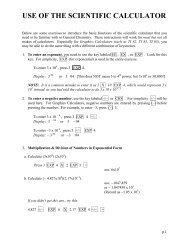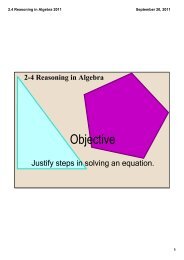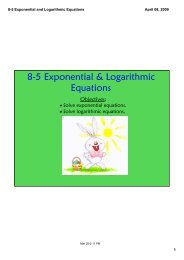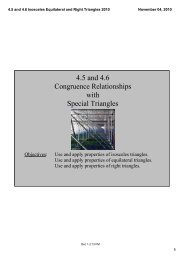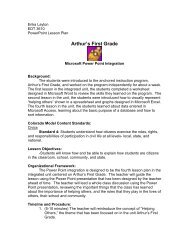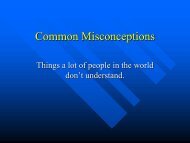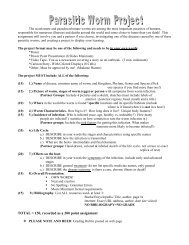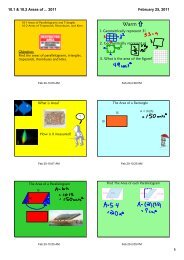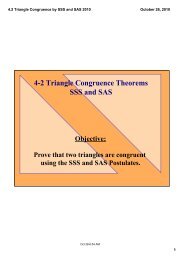Significant Figures PowerPoint
Significant Figures PowerPoint
Significant Figures PowerPoint
Create successful ePaper yourself
Turn your PDF publications into a flip-book with our unique Google optimized e-Paper software.
<strong>Significant</strong> <strong>Figures</strong><br />
Mathematics Involving Measurements Are<br />
Probably Different Than What You Are<br />
Used To.
Exact vs. Measured Values<br />
Most of the math we are taught involves using<br />
exact numbers.<br />
Exact numbers are used in science along with<br />
measurements, which are inexact numbers.<br />
Counted objects or defined values are exact.<br />
For example, the average person has 10 fingers.<br />
That’s a count.<br />
There are exactly 1000 mm in 1 m. That’s a defined<br />
value.
<strong>Significant</strong> <strong>Figures</strong><br />
So what the heck are significant figures, and<br />
how do we use them?<br />
Any measured value is a significant figure.<br />
If you measure a toothpick to be 4.72 cm long,<br />
there are 3 significant figures in the value: 4,7<br />
and 2.<br />
If the toothpick measured 4.70 cm, there are still<br />
3 significant figures.
<strong>Significant</strong> <strong>Figures</strong><br />
This brings up an interesting question: Are there<br />
digits that are not significant?<br />
The answer is, Yes!<br />
All non-zero digits are automatically significant.<br />
And zeros that show precision are significant.<br />
However, zeros that only serve as place holders,<br />
that is, they locate the decimal in a number, are<br />
not significant!
<strong>Significant</strong> <strong>Figures</strong><br />
A good guideline to follow is this: If zeros appear<br />
or disappear when you change the units of the<br />
measurement, the zeros are not significant.<br />
For example, 5 m has 1 significant figure.<br />
But 5 m = 5000 mm. Are the 3 zeros significant?<br />
No! They simply appeared because we changed<br />
units. Both numbers have 1 sig. fig.
<strong>Significant</strong> <strong>Figures</strong><br />
So, zeros at the beginning of a number (like<br />
0.00065) are always place holders and are never<br />
sig figs.<br />
And, zeros at the end of a number where the<br />
decimal place is implied (like 30,000), are also<br />
place holders and are not sig figs.
<strong>Significant</strong> <strong>Figures</strong><br />
But, zeros in the middle of a number (like 605)<br />
are not place holders. They are part of the<br />
measurement and are always sig figs.<br />
And, most importantly, zeros at the end of a<br />
number with a decimal place show precision.<br />
They are not place holders and are sig figs.
<strong>Significant</strong> <strong>Figures</strong><br />
This is one of the things your math teachers<br />
probably didn’t tell you.<br />
2.2 g ≠ 2.200 g<br />
The second measurement is much more precise<br />
than the first! The 2 zeros at the end of 2.200 g<br />
show precision and are sig figs.<br />
2.2 g has 2 sig figs, but 2.200 g. has 4!
<strong>Significant</strong> <strong>Figures</strong><br />
So the trick is to know when zeros are significant<br />
and when they are not.<br />
600 has only 1 sig fig, but 60.0 has 3.<br />
But, what happens if you were measuring the<br />
length of a table to the nearest 1 cm and it came<br />
out to be exactly 300 cm long?
<strong>Significant</strong> <strong>Figures</strong><br />
If the table had been 299 cm, there would be 3<br />
sig figs. Likewise if it had been 301 cm, 3 sig<br />
figs, right?<br />
How then do we show that the last zero in 300<br />
cm is significant?<br />
The answer is to put a bar over (or under) the<br />
zero to show that it was a measured value.
<strong>Significant</strong> <strong>Figures</strong><br />
To show that we measured our table to exactly<br />
300 cm, we write it this way: 300 cm.<br />
Since zeros at the beginning of a number with a<br />
decimal place are never significant, and zeros at<br />
the end of a number with a decimal are always<br />
significant, the only time we need a zero with a<br />
bar is in a number with no decimal place.
<strong>Significant</strong> Zeros<br />
A simple way to think about zeros is this:<br />
If zeros appear or disappear when you change<br />
the units or put a number in scientific notation,<br />
they were not significant figures.<br />
Ex: 6 m has 1 sig fig. 6 m = 6000 mm: still 1 sig<br />
fig.<br />
0.005 s has 1 sig fig. 5 x 10 -3 s has 1 sig fig.
Scientific Notation<br />
A word about scientific notation, numbers in<br />
exponential form.<br />
We use them frequently in chemistry, because<br />
we often have to deal with very large or very<br />
small numbers. And all those zeros get to be a<br />
pain.
Scientific Notation<br />
The classic example involves a number that<br />
chemists use all the time. The number is<br />
602,000,000,000,000,000,000,000<br />
It would be ridiculous to write the number out this<br />
way each time, so instead we use scientific<br />
notation: 6.02 x 10 23 . Much more efficient.<br />
This number has 3 sig. figs: 6, 0 and 2 in both<br />
the exponential and non-exponential forms.
Time to try your hand at sig figs.<br />
How many sig figs in<br />
each of these values?<br />
3.041 m<br />
0.000050 m 2<br />
3,480,200 yr<br />
-1.200°C<br />
1.0800 x 10 -2 L<br />
6000 m<br />
Let’s see how you did.<br />
Here are the answers<br />
4<br />
2<br />
5<br />
4<br />
5<br />
3
Still Confused?<br />
It is not unusual for people to still be a little hazy<br />
on significant figures at this point.<br />
So here’s a trick to help you figure out which<br />
digits are significant and which are not.<br />
It is called the Atlantic/Pacific model.<br />
Your teacher will show you the model on the<br />
board.
Rounding<br />
Round each to 4 sig figs.<br />
12,345,670<br />
2.35500<br />
1.4638 x 10 2<br />
0.000657030<br />
100,250.1<br />
23,475<br />
23,485<br />
Here are the answers:<br />
12,350,000 (1.235 x 10 7 )<br />
2.355<br />
1.464 x 10 2<br />
0.0006570 (6.570 x 10 -4 )<br />
100,300<br />
23,480<br />
23,480
Wait a Minute!<br />
No, that last answer was not a typo.<br />
This is another thing your math teacher probably<br />
didn’t tell you.<br />
When you learned to round, in grade school,<br />
your brain wasn’t ready for this idea.<br />
But now you are!!! (Isn’t that exciting?)
Rounding Exact Fives<br />
Five is that magic number that we are not sure<br />
about when rounding. To make things easy<br />
when you were younger, your teachers said to<br />
always round up.<br />
Scientists round exact 5’s so that the rounded<br />
digit to the left of the 5 becomes an even<br />
number.
Rounding Exact Fives<br />
This eliminates the mathematical bias introduced<br />
by always rounding 5’s up.<br />
So, rounding to the nearest 10, the number 75<br />
becomes 80 (just like you were taught), but 85<br />
also rounds to 80. Eight is even, where the 9 of<br />
90 is odd.<br />
5.5 becomes 6, and 4.5 becomes 4.<br />
What about 4.51?<br />
This is not an exact 5. It’s more than 5, so round<br />
up: 5.0



